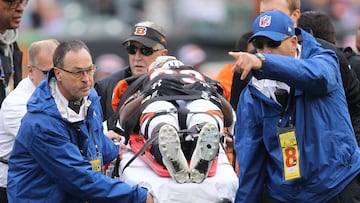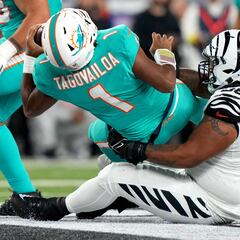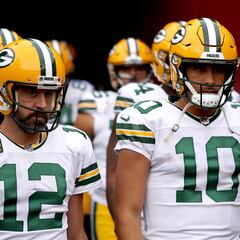Tagovailoa still raises concussion questions in the NFL
The Tua case prompted a change in the NFL’s concussion protocol. Today, the Dolphins quarterback is back and is still raising questions across the league.

Just three weeks ago, NFL fans had their hearts pounding for more than 10 minutes. Tua Tagovailoa, starting quarterback for the Miami Dolphins and an emerging star in the league, was tackled and violently thrown to the ground by Josh Tupou, defenseman for the Cincinnati Bengals, during the match between both franchises in the middle of North American prime-time. The Hawaiian remained on the ground, immobile and with the fingers of his hands seized, setting off all the alarms in the event of a possible serious injury. After being carried off the field and in an ambulance, knowing that Tua would recover from that concussion, a deep debate about how to manage these injuries began in the U.S., leading to important changes in the NFL.
Tagovailoa’s concussion was not just any, as it reflected a damage seen every week on football fields. To understand the dimension of the ‘Tua case’ we have to go back a week, when the Dolphins faced the Buffalo Bills at home. During the first half, the Miami team’s quarterback hit his head on the ground, clearly stunned. In his attempt to get up, Tua stumbled and returned to the floor. The 24-year-old player had to leave the game to be evaluated by doctors, as established by the NFL’s protocol for possible concussions. A team physician and a non-league neurotrauma consultant examined Tagovailoa, who underwent a review of the incident and a neurological exam that includes cervical spine checks and evaluations of speech, eye movement and gait. As established by protocol, If the player presented a concussion, he would be out of the game and would stay away from sports practice for a few days. If there was no evidence of a brain injury, he could return to the game.
The specialists had the last word., and to the surprise of many, Tagovailoa received the green light to return to the game, which ended with a victory for his team. However, a deep criticism was unleashed towards the Dolphins and his coach, Mike McDaniel, who were accused of having committed negligence, since the images shown of Tua demonstrated he had suffered a brain injury. “If he had had a head injury, we would have notified him, " McDaniel said, denying the allegations and reiterating that his quarterback had not suffered any serious damage. The NFL Players Association (NFLPA) joined the debate, and announced that it was opening an investigation to clarify what happened.
Related: Tagovailoa is back; played dangerously vs Steelers
Tagovailoa doesn’t remember being taken off field
The Dolphins decided to move on, and four days later they traveled to Cincinnati, where they started with Tagovailoa as the starter. The second blow to the Hawaiian’s head in less than a week multiplied the dimension of the matter, and the harsh images of the quarterback lying on the ground showed the need to thoroughly investigate what had gone wrong. “There was a point where I was unconscious. I remember the whole night up to the point where I got tackled, after that I don’t remember much. I don’t remember the moment they took me off the field, " Tagovailoa explained this week in his first appearance since the injury. Days after this scare, the NFL fired the neuro traumatologist who allowed Tagovailoa’s return against the Bills, although Jeff Miller, executive vice president of the league, assured that the established steps were followed correctly.
“Ataxia” incorporated in NFL
Without even having concluded the investigation into this case, in which everything indicates that a good number of recklessness was committed, the NFL and the NFLPA jointly announced that same week that the protocol for possible concussions changed immediately. In this new regulation, the term “ataxia” was incorporated, which is an anomaly in balance or stability, motor coordination or dysfunctional speech caused by a neurological problem. Until this change, a player with “gross motor instability” (difficulty getting up or walking, for example) could return to the field if the doctors consider that it was orthopedic reasons. With the new protocol, any player who shows this instability (as happened with Tagovailoa against Buffalo), will be permanently removed from the game, since it will be assumed that he suffers from a neurological injury.
The ‘Tua case’ has shown the growing concern in the American football world about brain injuries and the long-term consequences for players. Until 2016, the NFL did not admit the serious brain damage that the continuous practice of this sport can cause, and its protagonists receive constant blows to the head. Several studies have shown this relationship, and CTE (chronic traumatic encephalopathy) is no longer taboo. This degenerative brain disease, which can appear after repeated blows to the head and causes serious cognitive and behavioral disorders, is common among former American football players, and explains the high number of premature deaths and sad outcomes suffered by its protagonists. Dr. Bennet Omalu, known for discovering the CTE and its relationship with the NFL (his story inspired the movie ‘The truth hurts’), spoke these days about what he experienced with Tagovailoa, and he was very forceful about it. “If you want your life, if you love your family, you love your children, it’s time to bravely walk away from football. Stop playing. Stop. Hang up the helmet and walk away. Twenty billion dollars is worth no more than your brain,” suggested the doctor.
Tagovailoa played dangerously vs Steelers Week 7
Related stories
Far from saying goodbye to football, Tagovailoa returned to the starting lineup this week against the Pittsburgh Steelers on ‘Sunday Night Football,’ and it was not easy to watch him.
The quarterback confessed postgame that he did some things he “shouldn’t do,” but proceeded to explain that he was just trying to get forward.

